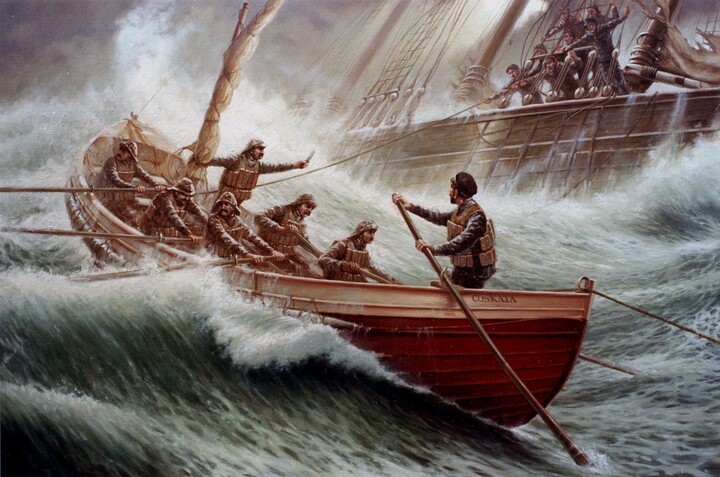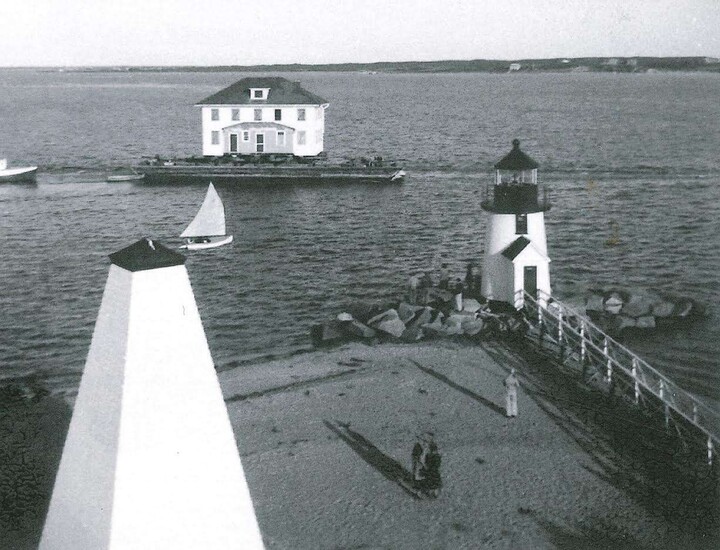
The History of the Island's Third Lifesaving Station
By Olivia E. Jackson
At the end of the 19th century, the “Graveyard of the Atlantic” was proving to be an apt description for the waters surrounding Nantucket. With a rise in schooner activity and marine trade interactions, the island’s shifting shoals and Nantucket’s infamous fog were increasingly dreaded by mariners. The growth in shipping traffic also led to a greater number of wrecked, stranded, or destroyed vessels around the island. Surfside Life Saving Station, opened in 1874, was the first and only station on the island at the time. But the increase in maritime disasters in the 1870s instigated government action and underscored the need to establish more lifesaving stations on other parts of the island.
During the summer of 1883, surveyors evaluated and later purchased land at Coskata for the construction and establishment of the island’s third lifesaving station. It was built just inland from Great Point Light, relatively near Coskata Pond. Construction was completed during the fall, and the station was officially opened on November 24, 1883. Captain Benjamin Pease, a Civil War veteran and experienced mariner, was named the first keeper of Coskata Life Saving Station.
The Coskata surfboat in Nantucket Harbor, late 19th century.
The station was situated in an ideal location to monitor, protect, and respond to incidents that occurred at the most northern point of the island. Located between Great Point and the eastern jetty shore end on Coatue, lifesavers could watch the waters to the east, west, and north. The station was built facing the Chord of the Bay, or the side of Great Point facing Nantucket Sound, as many shipwrecks had happened in this area. Shortly after the station opened, the crew responded to its first wreck. On the evening of February 20, 1884, the brig Merriwa, bound for Boston from New Jersey with 420 tons of coal, parted from her cables during an aggressive northwest gale. Later that night, she struck Great Point Rip. The Coskata crew successfully rescued the men aboard the brig and brought them safely ashore.
Coskata crew standing next to a surfboat, early 20th century.
Around 1887, Captain Benjamin Pease retired from his post as keeper at Coskata. He recommended Walter Nelson Chase, one of the original 1884 Coskata crew members, as his successor. Once in charge, Skipper Chase trained his men every day, tasking them with intense, rigorous drills to ensure that they were properly prepared for any maritime disaster. The result was one of the best boat crews on the east coast, which would later be proven during the great rescue of 1892. Skipper Chase and his Coskata crew heroically saved the souls on board the H.P. Kirkham, which had stuck the Rose and Crown shoal on the unforgivably cold evening of January 20, 1892. The rescue mission took more than twenty-four hours and is considered one of the most dramatic in the history of the Life-Saving Service. Skipper Chase and his Coskata crew were awarded gold Medals of Honor by the Congress of the United States.

The dramatic wreck and rescue of the H.P. Kirkham, depicted by marine artist Rodney Charman.
In 1915, the Revenue Cutter Service and the United States Life Saving Service merged to become the United States Coast Guard. This union redefined the role of the Life Saving Service, and in 1939, Coast Guard Station Brant Point was opened. In 1947, the Madaket Life Saving Station was consolidated with the Brant Point Station as new radio and radar technology dissolved the need for more than one site. The equipment building from the Madaket station was moved to Brant Point in the late 1940s. Shortly after, the same decision was made for the Coskata Life Saving Station.
In the 1930s, a station house was built at Coskata, which served as the accommodations for the surfmen and crew. However, roughly 10 years later, the Coskata Station was abandoned by the government shortly after the end of World War II. In the Saturday, December 3, 1949 issue of The Inquirer and Mirror, there was an announcement that the Coskata station house was to be moved to Brant Point to “further improve the crowded conditions there.” The 10-room, two and a half story building “will be moved to its new location on a barge in the same manner as the equipment building at Madaket was moved to Brant Point during the past summer.”

The Coskata Station House on a barge being pulled by a tug boat around Brant Point. Photo published in Mill Hill Press title Nantucket Lights by Karen Butler.
On an October day in 1950, contractors Turner & Breivogel of Falmouth, who had been commissioned by the government to move the station house, transferred the large building to a barge and towed it safely into Nantucket harbor. According to a Saturday, October 21, 1950 article published in The Inquirer and Mirror, “The little tug employed by Mr. Turner for his work, took the barge in tow and headed out for the end of the jetties. The ‘voyage’ was made without incident, and at 4:00 o’clock the tug and barge came in through the jetties, rounding Brant Point a quarter hour later.” The Coskata Life Saving Station building is still in use today and is part of Coast Guard Station Brant Point.

The Coskata Station House at Coast Guard Station Brant Point, circa 1965.